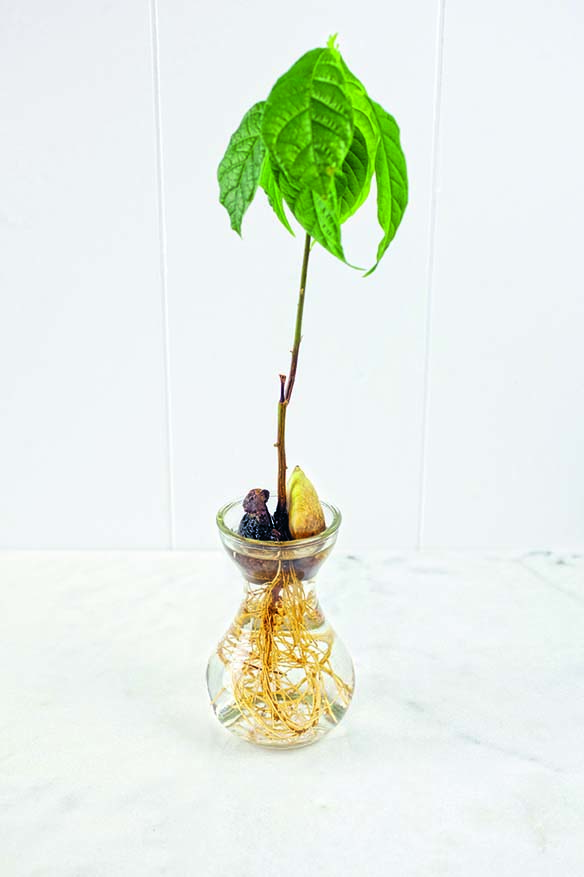How to grow an avocado tree from an avocado pit
Curious about growing avocado trees? Before you toss the avocado pit, consider growing your own with this easy tutorial. This is an excerpt from No-Waste Kitchen Gardening by Katie Elzer-Peters.
Avocado

Avocado trees growing in commercial groves are, like citrus, apple, and other fruit trees, grafted plants. The top is a known variety, and the bottom is a rootstock. As with citrus, growing an avocado from seed is more of a fun experiment in growing your own cool houseplant than it is a way to guarantee an endless supply of avocadoes
Avocados do not grow in temperatures lower than 20 degrees Fahrenheit, and those are the more cold-hardy varieties. Plants require anywhere from 5 to 15 years to produce fruit. They also do best when they have a cross-pollinator, which means you’d need two avocado plants. Where are you going to put two fully grown trees inside your house? Unless you’re lucky enough to have a fairly large greenhouse, you won’t have enough space to grow the trees to blooming maturity. Then, even if you raised two avocado trees from pits, the trees might not bloom at the same time, they might not bloom at all, or they might not be compatible, so you still might not get fruit.
Long story short, grow avocado pits for fun, not fruit. Here’s how.
How to Grow an Avocado Pit
You will need a sponge with a plastic scrubby side, three or four toothpicks, a glass or sturdy plastic cup or bulb jar, water, and, eventually, a flowerpot, potting soil, and a saucer to catch runoff.
1. Clean the avocado seed. It should be fairly easy to just run the seed underwater and gently remove the pulp from around it. If you need to, you can use the scrubby side of a plastic sponge to remove any sticky bits.
2. Identify the top and bottom of the seed. The bottom part of the seed will usually be a bit broader than the top part of the seed. Sometimes the top is pointy. (If you think about this ahead of time, you can mark the top of the seed by making a scratch on the top of the seed before you take it out of the fruit because it’s easier to tell which side of the fruit is the top.)
3. Stick the three or four toothpicks into the avocado pit at about mid-level in the pit. They should be evenly spaced. These toothpicks are what will hold the pit at a steady spot in the glass.
4. Fill the glass with room-temperature water. The water should come just about to the top of the glass — any size of glass will work for this.
5. Place the avocado pit/toothpick assembly on the glass so that the bottom of the pit is submerged in water.
6. Set the glass somewhere warm but not in direct sunlight. Change the water once a week or so, just to keep it fresh and prevent bacteria and fungi from growing. Make sure the water that you use to refill the glass is at room temperature
Keep Growing!

The avocado pit will sprout a taproot from the bottom of the seed and a shoot (stem) from the top. You’ll know that the stem is about to emerge when you see the top of the seed start to crack. Never let the taproot or bottom of the seed dry out while it is growing in water
Once you start to see a shoot emerging, you can move the plant to an area with more light
When the plant is between 6 to 12 inches tall, plant it in a 12-inch diameter flowerpot. Leave the top of the seed exposed. Do not cover
To keep the plant houseplant-sized and not avocado grove-sized, trim the plant back by half when it is between 12 to 18 inches tall. This will promote side shoots to grow. You can tip prune to maintain size. When the plant has outgrown your space and pruning affects the aesthetics, simply start a new pit and begin again!
growing tip: Do not let the avocado pit dry out. Start the rooting process immediately after removing the pit from the fruit or wrap it in a wet paper towel and store in a container on your counter until you can get to it
This piece, “Avocado,” is excerpted from No-Waste Kitchen Gardening by Katie Elzer-Peters. Used with permission of the publisher, Cool Springs Press (Quarto).


My avocado tree is about 12 inches tall. There is a 1 inch section at the top that is black and new growth is starting above the black portion. Should I cut the black stem?